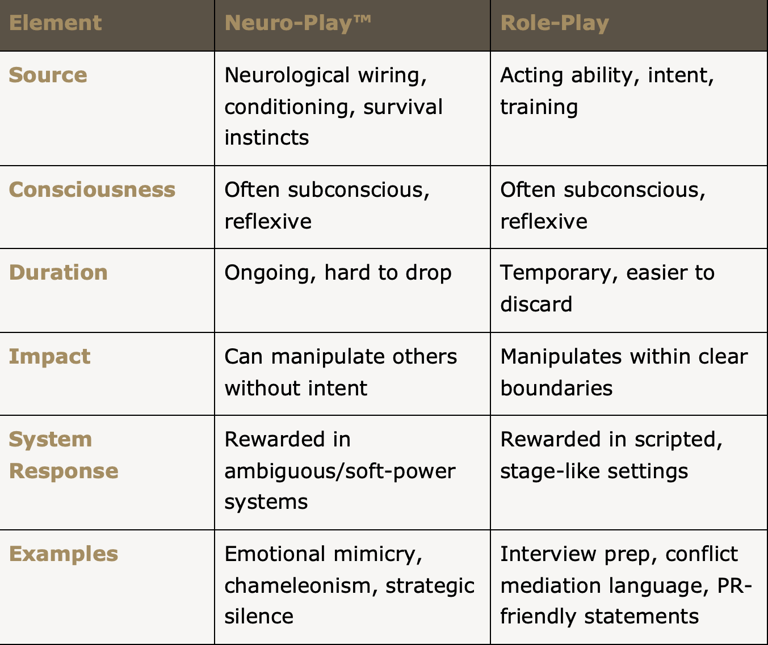Neuro-Play vs Role-Play™: Understanding Performance, Identity, and Survival in High-Pressure Systems
2 min read
Neuro-Play vs Role-Play™ is a framework that distinguishes between unconscious, survival-driven behaviours rooted in neurocognitive wiring – such as masking, trauma responses, or emotional mimicry – and conscious, deliberate performances adopted for a specific purpose. While Role-Play involves intentional personas that can be stepped into and out of, Neuro-Play is often reflexive, persistent, and misunderstood as authenticity or manipulation. This distinction matters in environments that reward soft power and surface-level charm, where Neuro-Play can unintentionally cause harm while protecting those who appear genuine. Recognising the difference helps us avoid misjudging others and prevents the uncritical rewarding of behaviour that may be rooted in survival, not strategy.


What if the most convincing performances aren’t performances at all? What if some of us aren’t pretending – we’re surviving?
Welcome to Neuro-Play vs Role-Play™, a framework I developed to explore the often-invisible dynamics of performance, particularly in systems that reward social intuition, ambiguity, and soft power.
This isn’t just about masks. It’s about what happens when your cognitive wiring becomes your strategy for survival – and how easily that can be misread as performance, manipulation, or charisma.
What Is Neuro-Play™?
Neuro-Play™ refers to the unconscious, often neurologically-driven ways people navigate high-pressure environments. These performances don’t come from acting skills or social training – they emerge from cognitive defaults, conditioned responses, and survival instincts.
Neuro-Play™ is:
Not acting.
Not a role.
Not a game.
It’s a lived, often continuous state – shaped by neurodivergence, trauma history, masking patterns, or finely-tuned survival instincts. And because it appears authentic or vulnerable, it often goes under the radar – even when it causes harm.
By contrast, Role-Play is:
Conscious
Deliberate
Temporary
Role-Play is a persona you choose. Neuro-Play™ is the reflex you become.
Neuro-Play vs Role-Play™: A Core Comparison


Key Ideas Within the Framework
Cognitive Strategy as Survival
Not everyone is “playing a role.” Some are surviving by default – unconsciously leveraging their neurocognitive setup to stay safe, liked, or employed.
Unwitting Harm
Neuro-Play™ can be just as impactful as strategic manipulation. The difference? It’s often protected from scrutiny – because it looks real.
Power and Plausibility
This framework matters most where power dynamics are at play. Neuro-Play™ thrives when paired with identity protections, institutional cover, or proximity to influence.
The Lie Lived-In
Role-Play is a role you step into. Neuro-Play™ is a mask you live behind – sometimes without even knowing it’s there.
Why This Matters
We live in systems that reward soft skills, emotional intelligence, and surface-level authenticity – especially in workplaces, activism spaces, and online platforms. But not all “performance” is performance.
Some of it is survival.
Some of it is trauma.
Some of it is cognitive wiring misread as charisma.
And until we can tell the difference, we risk misunderstanding – or worse, rewarding – dynamics that cause real harm, simply because they appear relatable, earnest, or polished.
This framework helps us start to see the difference.
What do you think...?
© It’s Nadine™ | Neuro-Play vs Role-Play™
For educational, analytical, and commentary purposes only. If referencing or teaching, please cite and attribute authorship.
